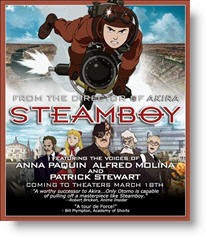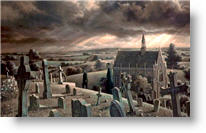Steamboy
 for action violence.
for action violence.
Reviewed by: Michael Karounos
CONTRIBUTOR
| Moral Rating: | Better than Average |
| Moviemaking Quality: |
|
| Primary Audience: | Teens Adults |
| Genre: | Animation Sci-Fi Action Adventure Drama |
| Length: | 2 hr. 6 min. |
| Year of Release: | 2004 |
| USA Release: |




| Featuring |
|---|
| Anne Suzuki, Manami Konishi, Katsuo Nakamura, Masane Tsukayama, Kiyoshi Kodama |
| Director |
|
Katsuhiro Otomo |
| Producer |
| Kazumi Kawashiro |
| Distributor |
According to an interview with “Steamboy” director Katsuhiro Otomo in “Dark Horizons”, Otomo admits that “The terror attack on Sept. 11 and the war in Iraq had a big impact as social phenomena, and they may have influenced the film somewhat.” In a silly season of sci-fi/action films in which David Koeppe, the writer for “War of the Worlds”, claims he conceived of the Martians as the American military, and George Lucas implied that the Emperor and the Empire are Bush and 9/11-inspired, Otomo’s comment is refreshingly helpful for the fraction of one percent of filmgoers who bothered to research the film before seeing it. At least they knew they would be seeing an anti-American movie and anti-Christian movie. But what about everyone else? What message does “Steamboy” communicate as a film to the unsuspecting viewer?
The action of “Steamboy” takes place in Victorian England in 1866, but the movie derives some of its political inspiration from the European revolutions of 1848, as well as from the current international animosity against the United States. The premise of the movie is that the American military-industrial complex, represented by a pubescent character named Scarlett O’Hara, seeks to make money from selling weapons in Europe. The subsequent arms race destroys the international, U.N.-type harmony that the London Exhibition represents.
The problem with this mythology is that Europe was in a revolutionary turmoil at this time due to what Marx called its “internal contradictions.” France was trying to take over parts of Italy; England was trying to prevent the German states from uniting, and, except for England, Russia, and Belgium, revolutionary movements erupted everywhere. Additionally, the 1840s witnessed massive crop failures such as the Great Potato Famine in Ireland which killed an estimated four million of the country’s eight million inhabitants, and the crop failures in Germany. Those disasters prompted a human-wave emigration to the United States from both of those countries.
It is in this approximate time period that Otomo sets his parable about unbridled power in the hands of “arrogant and self-interested” powers. The invention at the heart of the movie’s allegory is the “steamball” which compresses within a sealed, steel chamber a substance taken from underground. The weapon of mass destruction is light enough for a child to hold but powerful enough to destroy buildings: the 19th century’s equivalent of a briefcase bomb.
In this instance, the substance is pure water from subterranean caves in Iceland. The implicit comparison is to uranium, since the steamball looks like a miniature reactor.

Supporting this interpretation are the images of London at the end of the movie which seem like mushroom clouds blossoming in London’s center. For a Japanese citizen born in the wake of the twin horrors of Hiroshima and Nagasaki, technology unleashed without moral control is a living monster that devours not only lives and cities, but the souls of its caretakers, as when Loyd accuses his son of being “a fool who sold his scientist’s soul to the capitalists.”
The primary characters represent different strains of ideologies. Loyd, the grandfather (voice by Patrick Stewart), wants to use the great power of the steamball to entertain the masses. His contribution, mocked by his son Eddy, is the amusement park whose apparatus projects from the Steam Castle (a self-conscious replication of Lucas’ Death Star) in the same way the cannons do. The juxtaposition of amusement park rides and images of carousel horses, with the destruction caused by the Steam Castle at the end of the movie, is a commentary on the grotesque synthesis of war as entertainment (or, Christians might justifiably counter, entertainment as war).
Loyd also represents a satirical commentary on the patronizing governments of the ruling class that the revolutions of 1848 were directed against. He deteriorates by film’s end into a type of John the Baptist character: wild-eyed, half-naked, wild-haired, railing against his son who he says is using the “devil’s handiwork to kill men by the thousands.” Intriguingly, he is shown in the closing credits superimposed on a cross, and then dissolving so that the cross is superimposed on him. Otomo’s message is clear: the identification of Christianity with the patriarchal class in Europe. This is figured by Loyd’s John the Baptist dress, by his religious language (hell, devil, soul), and by the cross imagery.
Eddy (voice by Alfred Molina) is Loyd’s son, and in one of the central segments of the film he argues with Loyd and claims that science exists “to make all humanity equal.” The father’s egalitarianism is representative of the nascent socialism of the time, a motif echoed by the fact that much of the action takes place in Manchester, a city described by Engels in 1844 in his book The Conditions of the Working Class Poor in England. This landmark text influenced Karl Marx and led to the writing of The Communist Manifesto in 1848 which proclaimed, “A spectre is haunting Europe—the spectre of communism.” Otomo’s subject of steam power as an oppressive instrument in the 19th century is identified by Marx and Engels as one of the reasons why Communism had become a necessary ideology:
Meantime, the markets kept ever growing, the demand ever rising. Even manufacturers no longer sufficed. Thereupon, steam and machinery revolutionized industrial production. The place of manufacture was taken by the giant, MODERN INDUSTRY; the place of the industrial middle class by industrial millionaires, the leaders of the whole industrial armies, the modern bourgeois.

The combination of “industrial armies” is precisely the formula of the communist phrase the “military-industrial complex.” So, when Eddy histrionically exclaims that “Science is power!,” the grandfather responds “Madness!” because it is a leftist ideology which threatens the grandfather’s control of technology. Eddy at another point preaches “Man will be freed from long, hard labor. We will deliver this enormous power to the entire world!” Otomo then shows Eddy with his arms outstretched in a crucifix position, a visual echo of the image of Loyd in the concluding credits.
By doing so, Otomo seems to implicate Communism as an equally deluded, prophet-driven ideology which seeks power for its own reasons. Otomo argues that idealism is at the heart of all the competing interests, but an idealism gone wrong.
 This image of Eddy then dissolves and another image is superimposed on it: the emblem of The Royal Order of the Garter, worn by the Admiral, in the center of which there is a cross.
This image of Eddy then dissolves and another image is superimposed on it: the emblem of The Royal Order of the Garter, worn by the Admiral, in the center of which there is a cross.
While Eddy and Loyd represent the conflict between the nobility and the lower classes, Robert Stephenson, in concert with the Admiral, exist as a counter-balance to represent the interests of capitalism in the service of nationalism. When the steamboy, Ray (voice by Anna Paquin), asks him what science is for, Stephenson responds: “Science exists to make people happy…[but] the basis of that happiness, the nation, must be preserved… There is no happiness without the nation.”
Stephenson and his young associate enter the film as unambiguous protagonists, but by film’s end the associate has been seduced by the power of the steamball and goes over to the dark side.
The only ridiculous character in the film is the American, Scarlett O’Hara, who Otomo admits naming after the character in “Gone with the Wind”. She is the heir of the O’Hara Foundation which we learn from the Admiral sold arms to both sides in the Civil War and now wishes to arm everyone in the world with the explicit purpose of making money. Scarlett is a wealthy spoiled brat, accustomed to commanding and being obeyed. She is also a bully who is shown striking her pet Chihuahua on two separate occasions. The Chihuahua’s name is Columbus, and the dog represents America’s relationship to Old Europe: immature, domineering, violent.

Scarlett has no concern for anyone but herself and is shocked at one point in the battle between her “steam troopers” (fascist proto-types of “storm troopers”) and the English army that there are men inside the machines who bleed and die.
Scarlett’s character becomes interesting when read in the context of the Mexican-American War (1846-1848). After that conflict, and in response to the European turmoil, a “young America” movement sprung up, fueled by Democrats and some jingoistic publications. The movement wanted the United States to get involved in the upheavals in Europe and advocated military aid to Germany and Hungary. Scarlett would seem to be a representation of this “young America”: hers is a naïve idealism that solves all problems by force and is ignorant of the power she wields and the destruction it causes.

The film’s anti-Christian message comes into focus during the dedication of the Crystal Palace. As the priest prays, “As Jesus said, ‘The Kingdom of God is at hand,’” a battle is taking place outside the Crystal Palace and is being watched through the glass, as on a movie screen, by a languid and unconcerned representative of the upper classes. The phrase “palaces and churches” identifies the alliance of the monarchy with religion, emphasized by the fact that Queen Victoria is in attendance during the prayer. These elements, combined with the cross imagery that has already been mentioned, is convincing proof that Otomo is not limiting his critique solely to U.S. government, but extends it, specifically, to our Christian faith.
This is doubly ironic since it was the religious monarchy of Otomo’s Japan that tried to conquer the world a scant 60 years ago, and since it was the imperial ideology of Communism that put the Iron Curtain around Eastern Europe and seeks to replicate itself by fomenting violence in other societies. That the Left (in its endless series of movies on similar themes) seeks to project their own intentions onto the United States simply reveals their denial of their own destructive nature and totalitarian ambitions.
Clearly, this is a complex movie, as one would expect from a project that took nearly nine years to complete. Otomo’s purpose is ideological and reflects the anxiety of left-leaning people around the world.
To us in the United States, their fears that our country is somehow interested in conquering the world are hysterical. They underestimate our materialism if they think we Americans would rather have our sons die in Iraq than allow them to live their lives comfortably apart from the constant upheaval that characterizes our broken world.
But ours is a complex nation. The Christians in it have an evangelical imperative; the business class has a capitalistic imperative, and the cultural and political leftists in our midst have a socialistic imperative. These are the three great forces that are contending for power in our country and, in Marxist terms, it is the cultural leftists who control the means of production and who can produce science fiction movies such as “Steamboy”, “The Jacket”, “Equilibrium”, and “The Planet of the Apes” in order to portray Christianity as an oppressive and violent faith. The depiction of the Christian faith as violent and fascist in the context of our terror-filled time is, needless to say, deeply ironic.

“Steamboy” is a beautifully illustrated film and should be seen for the art alone. That its ideology is anti-American and anti-Christian is disappointing, but Christians have a living belief, one centered in a Savior much larger than oppressive ideologies that rise up and fall in seventy years, like Communism, and much larger than the fatuous ideologies whose cultural productions consist of attacking our country and our faith but which themselves only destroy lives through gulags and oppressive governments.
Our faith transforms lives through God’s love, justice, and mercy. While these political and cultural kingdoms rage and fall, Christians will still be spreading the gospel. All that’s expected of Christians as they come into contact with counter-evangelical tools such as this film is that they be well-informed, culturally as well as biblically. That’s why it is useful to see films like this: to learn the forms by which culture communicates its hatred for the values of our faith and our country so that we learn to recognize them in other genres and media.
Violence: Heavy / Profanity: None / Sex/Nudity: None



In terms of the technical and artistic quality. It has quite a stunning 2D and 3D CG effect. The quality of the animation is also quite high, but nothing special when compared to other animes. The mechanical designs are quite detailed. etc, etc. All in all, just really beautifully done visually.
Can’t comment on the audio part because I did not watch the dubbed version. The sound effect for the Japanese version was quite good, as well as the voice acting.
The plot is okay; but for me personally, it does drag on quite a bit in the middle and at the end, talking about pseudo-philosophy or whatever. However, it’s quite action packed at various point. And light humor can be found throughout the film.
Final Opinion, if you are just wanting to be entertained or whatever, then maybe there are better options to choose from and better ways to pass time, besides from this animated movie. Although the technical and artistic quality of this movie is quite high, there are better animes out there. If you are somewhat into anime, then maybe you should consider seeing this in the theater, or getting it from Blockbuster, or waiting for it on cable. If you are an otaku like me, (Christian, Catholic, or not) catching it on the big screen is the first thing to do.
My Ratings: Offensive/3